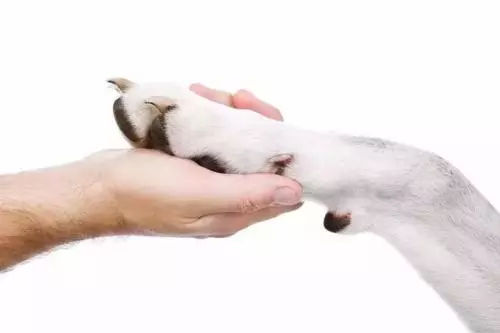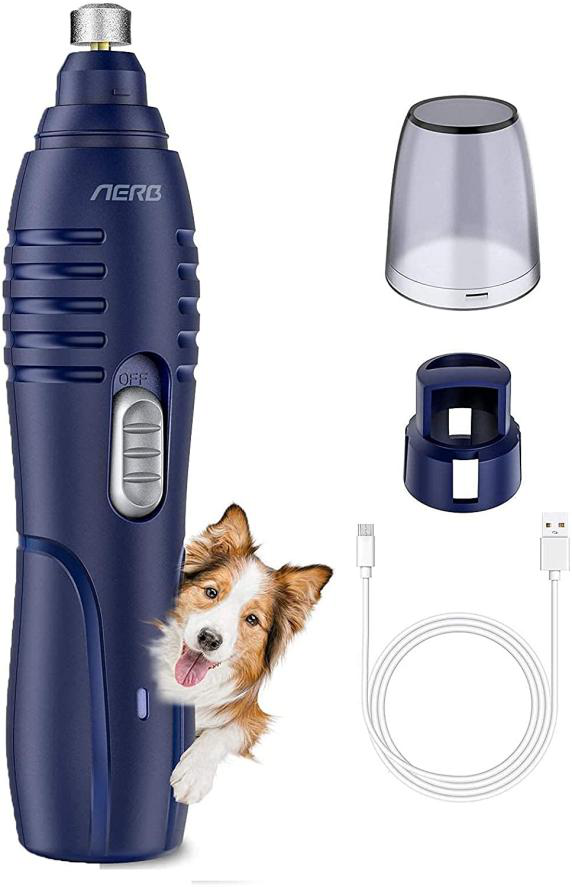Clipping a dog’s nails is one of the scariest grooming tasks faced by pet owners. If you’re not experienced in this area of home grooming, you’re probably intimidated by the thought of the task. Products like the AERB Dog Nail Grinder allow you to slowly file down the nail instead of quickly clipping off the end.
A dog nail grinder can be intimidating to the uninitiated. While doggy pedicures are necessary, you may be a dog owner who lacks the confidence needed for cutting your dog’s nails at home. Pet nail grinders offer a less stressful and easier option than alternative dog nail trimmers.


Why Do We Need to Clip Our Dog‘s Nails?
Nails provide traction for your dog. If they’re too long, they can throw off your dog’s natural sense of balance. Once nails get too long, they can also put pressure into your dog’s paw, causing discomfort and even pain.
What are Dog Nail Grinders?
Nail grinders are designed very differently than nail clippers. They work to grind your dog’s nails down with a rough tip that feels like sandpaper. Instead of quick clips, the dog’s nails are filed down incrementally at high speed. Nail grinders use batteries or electricity to keep the tip moving.
An electric pet nail grinder is simply a high speed. They are recommended alternatives to nail clippers for pets who don’t appreciate standard pedicures and manicures. The nail grinder grinds away at the nail little by little rather than clipping it off. Effectively, a dog nail trimmer and a nail file in one.


Will They Work for Small Pooches and Large Dogs?
While small dogs will require less power behind the grind and a less coarse grinding bit than larger breeds, both will benefit from a suitable pet nail grinder.
Safety First
Using a grinder can be dangerous, so the first thing you want to do is make sure there will be no hair in the way. If your dog has long hair, you need to band it back so there’s no chance it can get caught in the grinder’s spinning tip. If your dog has long hair on his paws and between his foot pads, it’s best to trim it first to lessen the risk of catching it in the grinder. For first-timers, use the slowest speed on the grinder, until you and your pup are at ease with the tool.
Steps for Grinding Nails
- Always select the correct grinding band before you start. Hold the dog securely with his paw extended. Always be prepared to stop temporarily if the dog struggles, and you need to position him again before proceeding.
- Working on one nail at a time, gently apply the grinder to the bottom of the nail tip, and slowly bring it up and around to the top of the nail tip. When you reach the top of the tip, work back down to your starting point again.
- Repeat this process several times until you’ve removed the sharp tip, but not so much that you grind into the quick and make the nail bleed.
- When you’ve taken off as much length as you need to, gently apply the grinder in a circular motion around the tip several times to polish it smooth.
- Repeat the entire process on each of your dog’s nails.
(QUICK TIP: turn off your grinder in between nails. This will help delay how quickly it warms up.)
Benefits of Dog Nail Grinders
There are several advantages to using a grinder versus a standard dog nail trimmer.
- Grinding is virtually painless when it’s done properly, although your dog may need to become accustomed to the vibration of the grinder head against his nails.
- Harder to cut quick: You can accidentally cut the quick with clippers or grinders, but since you’re slowly grinding down the nails with a grinder, it’s much easier to avoid catching it. You’re far less likely to expose the nail quick and cause bleeding.
- Good for thick nails: Grinders are good for dogs with thick, black nails as it’s harder to see how short they are with a clipper.
- Allows smoother nails: One reason many dog owners love nail grinders is that you can smooth out the nails rather than leave the sharp edges that come from nail clippers. This leads to fewer scratches on your clothes, furniture, and skin.


Additional Tips with Dog Nail Clippers and Grinders
It can take some time to get the hang of using a grinder, and your dog might have some reservations of his own.
1. Make sure to pick a dog nail grinder that is tolerable in sound for your dog. Slowly introduce your dog to the sound until they are used to it. Do this by turning on the grinder and offering him some irresistible treats. This way, he can begin associating the sound with a pleasant reward. If the loud noises cause too much anxiety, they may be better off with nail clippers.
2. Even though it’s easier to cut the quick with clippers, it still can be done with grinders. Make sure you don’t to grind your dog’s nails too short.
3. If you like the smooth look given by grinders, you can still use a clipper to cut the nail and a grinder to smooth the nail.
4. Make sure the grinder is comfortable in your hand since discomfort can lead to cutting your dog’s quick.
5. If your grinder comes with different size stones and grit sanding bands, you may have to experiment to find which one you like working with best.
6. Grinding creates heat which may frighten your dog a bit. Be prepared to take your time and give your dog breaks the first few times you use the grinder. He’ll eventually get used to the warmth, as well as the way the grinder feels against his nails. You can also work on each nail a little at a time to keep heating to a minimum.


Diamond Bit and Stainless Steel: Safe, Quality Aerb Electric Dog Nail Grinder
2 Speed Grinder – Put a finger on your particular requirements by determining your pup’s unique likes and dislikes and personal needs. The size of a pup determines the power needed behind the grind. Age and breed might also be factors in the thickness and hardness of the nail.
Unique appearance design – An ergonomic grinder with rubber grips is easy to manipulate and hold and is best for both pup and pedicurist. A pup who shies away from noise or vibrations may not be the ideal candidate for a raucous or overly pulsating grinder. Choose a quiet dog nail grinder.
3 Ports meet all needs – Various grinding tips cater to various sizes and breed of dog. Better quality grinders offer a choice of grinding stones and grit bands and more than one grinding speed option. Diamond and stainless-steel bits are most durable and efficient, with the diamond bits offering more consistency.
You’ll Never Know Unless You Try
Will a grinder be the right solution for your pet’s nail trimming needs? You really won’t know until you use one. if your dog currently struggles when you try to use regular trimmers, you may find it worth your while to make a small investment in a trimmer, and see if your pet is less resistant to having his nails done. If you like the results, you’ll know you’ve made the right choice.
Frequently Asked Questions On – Dog Nail Grinding
1. How Often Should I Grind My Dog‘s Nails?
In general, you should need to cut your dog’s nails every 1-2 months. Also, if you hear your dog’s nails hitting the floor a.k.a. ‘clicking’ it’s time to trim your dog’s nails.
2. Do Grinding A Dog‘s Nails Hurt Them?
Overall, no. One of the main reasons why dog owners switch to grinder form traditional scissors clipping is because they can’t hurt their dog. However, if you are not careful you can provoke pinching. Pinching can cause discomfort and pain, even if you don’t cut into the quick.
3. Do Long Nails Hurt Dogs?
Too long nails can be painful for dogs. Long nails can cause a dog to lose traction in their paws, making it significantly easier for them to fall and slip. This can cause additional pain in the nail alone.
4. Does Walking Your Dog Trim Their Nails?
You have to trim dog’s nails regularly. However, taking your dog out on walks outdoors can help cut down on the number of trimmings a dog needs. Also, dog’s who don’t run or walk will need their nails trimmed more often.
5. Should You Hear Your Dog‘s Nails On The Floor?
Some breeds have so short nails that you can barely see them, such as the Doberman Pinscher. However, this is not a rule. The commonly accepted rule is that when a dog is standing, the nails shouldn’t make contact with the ground. If you hear your dog coming, it means that his nails are too long.


